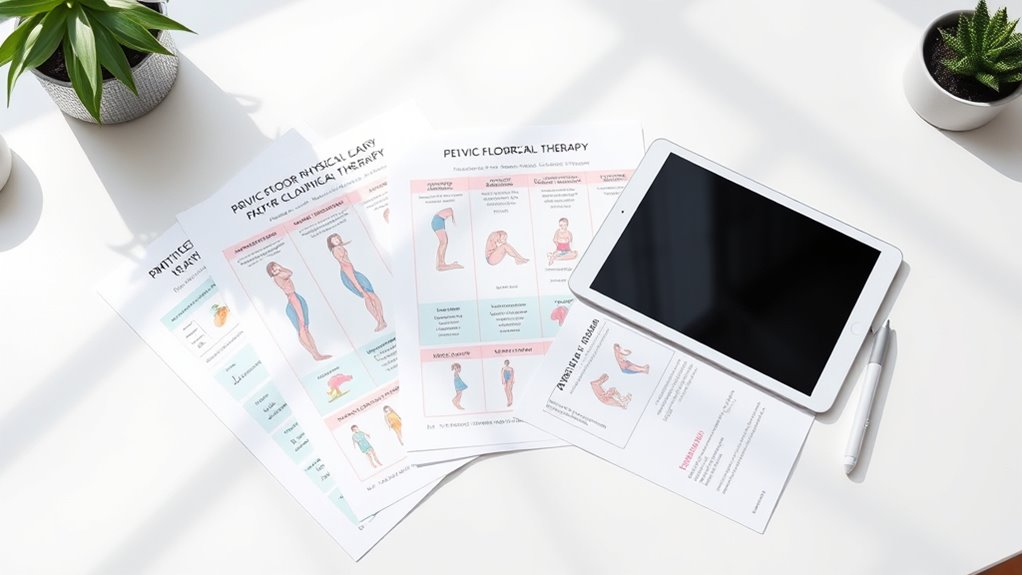A Pelvic-Floor PT Week Challenge with printables offers a structured way to improve your pelvic health through daily exercises, education, and progress tracking. You’ll set goals, perform targeted workouts like Kegels and bridges, and learn proper breathing and posture techniques. Using printable guides helps keep you motivated and organized as you celebrate milestones. Keep going, and you’ll discover how to maintain your pelvic health long-term with practical tips and support.
Key Takeaways
- Provides printable guides to track pelvic health goals, exercises, and progress throughout pelvic-floor PT week.
- Includes educational resources, activity instructions, and motivational tools to support learning and engagement.
- Offers structured routines with exercises like Kegels, bridges, and pelvic tilts to improve strength and control.
- Features tracking charts and celebration pages to monitor improvements and celebrate milestones.
- Emphasizes long-term maintenance tips, lifestyle habits, and professional support resources for pelvic health.
Setting Up Your Pelvic-Floor Wellness Journey
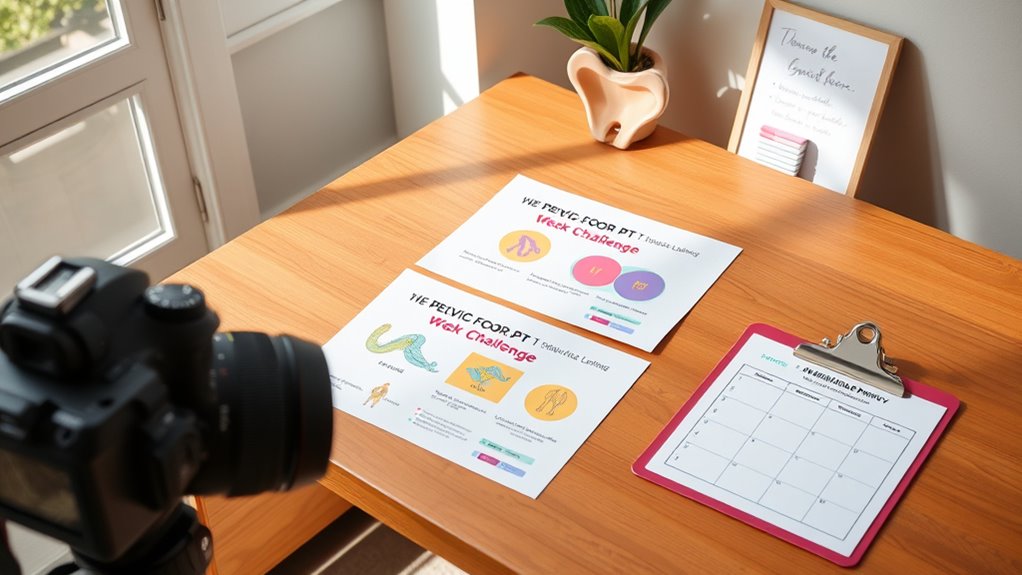
Starting your pelvic-floor wellness journey begins with understanding your current health and setting clear, achievable goals. Take time to assess how your pelvic area feels—any discomfort, weakness, or pressure? Knowing your baseline helps you identify priorities and track progress. Write down your goals, such as improving strength, reducing discomfort, or regaining control. Be specific yet realistic, and set a timeline for these objectives. Consult a healthcare professional if needed, especially if you’ve experienced significant issues. Remember, this is about creating a personalized plan that motivates you. Focus on understanding your body and what you want to achieve. Incorporating positive reinforcement techniques can help maintain motivation throughout your journey. With a solid foundation, you’ll be ready to take proactive steps toward better pelvic health.
Daily Exercise Routines to Strengthen Your Pelvic Floor
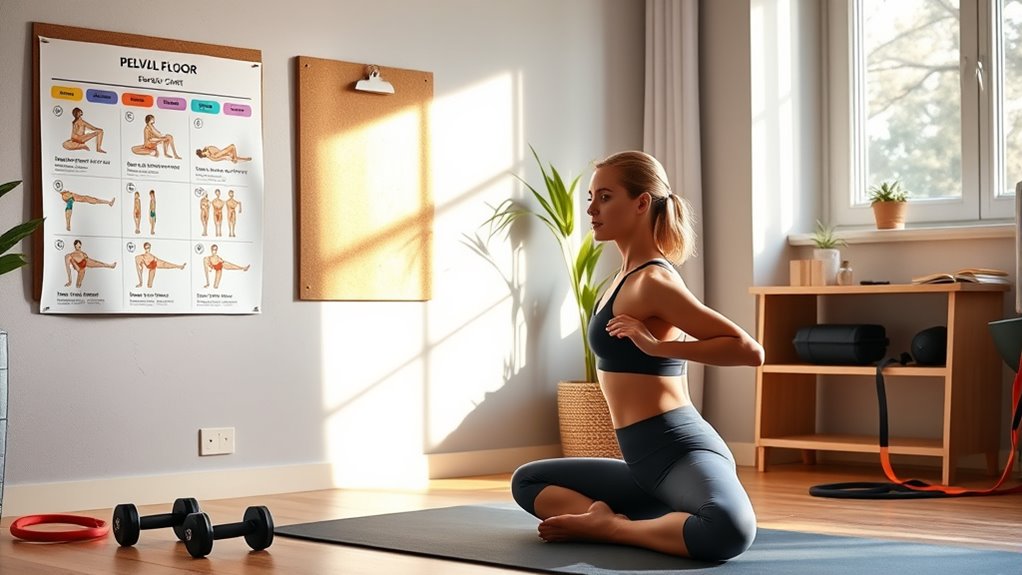
Building on your understanding of your pelvic health, establishing a consistent daily exercise routine can considerably strengthen your pelvic floor muscles. Incorporate simple, targeted exercises into your day to see improvements over time. Here’s a quick guide to daily routines:
| Exercise Type | Benefits |
|---|---|
| Kegel Exercises | Improve muscle tone and control |
| Bridge Pose | Strengthen pelvic and glute muscles |
| Squats | Enhance core stability and strength |
| Pelvic Tilts | Increase flexibility and muscle activation |
| Deep Breathing | Promote relaxation and muscle engagement |
Developing a routine can also improve your overall well-being, making these exercises even more beneficial.
Educational Activities to Increase Awareness

Increasing your awareness of pelvic health is essential for effective management and prevention. Engaging in educational activities helps you understand your body better and recognize early signs of issues. Start by reading reputable articles or watching videos on pelvic anatomy and function. Attend workshops or webinars focused on pelvic health to deepen your knowledge. Keep a journal to track symptoms and questions to discuss with your healthcare provider. Participating in support groups can also boost your understanding through shared experiences. Additionally, use printable guides or handouts to reinforce key concepts. Incorporating educational toys that promote cognitive and sensory development can also enhance your understanding of body awareness. By actively seeking information and staying informed, you empower yourself to make proactive choices that support long-term pelvic well-being. Education is a crucial tool in demystifying pelvic health and fostering confidence in managing your body.
Tracking Your Progress and Staying Motivated
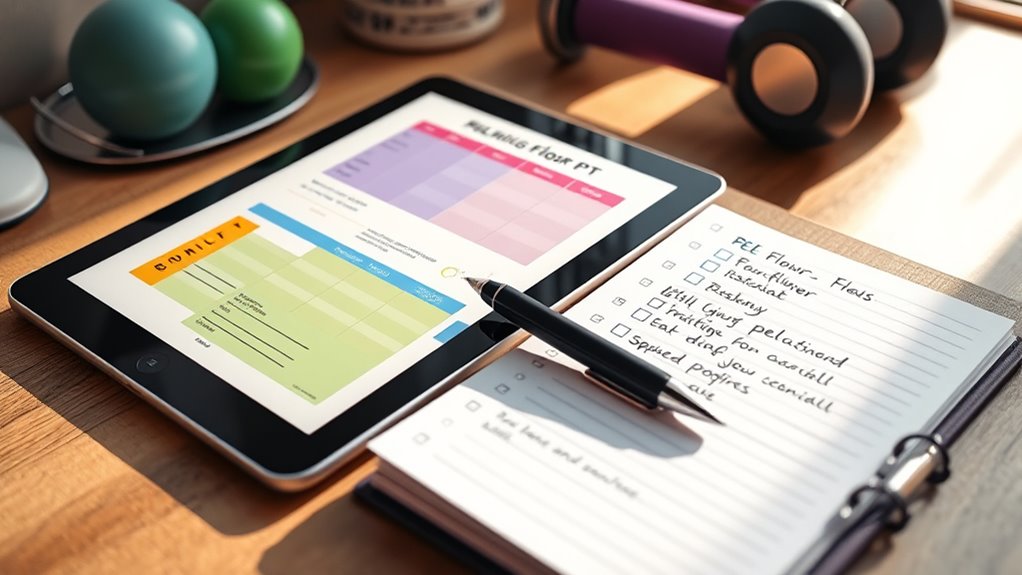
To stay motivated, it helps to set clear goals so you know what you’re working toward. Celebrate small wins along the way to keep your spirits high and maintain momentum. Tracking your progress makes it easier to see how far you’ve come and adjust your efforts as needed. Additionally, incorporating motivational resources can provide encouragement and reinforce your commitment to the challenge.
Setting Goals Clearly
Setting clear goals is essential for staying motivated and making steady progress in your pelvic-floor therapy journey. When you define specific, measurable objectives, you know exactly what you’re working toward. Instead of vague intentions like “improve my pelvic health,” set precise targets, such as “perform daily pelvic exercises for 10 minutes, five days a week.” Clear goals help you stay focused and give you a sense of direction. Write them down and revisit regularly to track your progress. Break larger goals into smaller milestones to keep yourself motivated and avoid feeling overwhelmed. Remember, achievable and realistic goals make it easier to stay committed and see results. With well-defined goals, you’ll feel more confident and in control of your recovery. Incorporating specific, measurable objectives can further enhance your motivation and progress tracking.
Celebrating Small Wins
Celebrating small wins is a powerful way to keep yourself motivated along your pelvic-floor therapy journey. Every time you notice improvement, no matter how minor, take a moment to acknowledge it. These wins build your confidence and remind you that progress is happening. Keep track of your achievements, like completing a set routine or feeling less discomfort. Celebrating these moments helps you stay focused and positive, even during challenging days. Remember, success isn’t just about big milestones—it’s about recognizing every step forward. By celebrating small wins, you reinforce your commitment and keep your motivation high. Over time, those little victories will add up, leading to meaningful change and a stronger, healthier pelvic floor. Monitoring your progress and understanding red flags can help you identify when to seek additional support or adjust your routine.
Tips for Proper Technique and Breathing

Maintaining proper technique and breathing during pelvic-floor exercises is essential for maximizing their benefits and preventing injury. Focus on engaging your pelvic muscles gently without overdoing it, and avoid holding your breath. Inhale deeply through your nose, allowing your abdomen to expand, then exhale slowly through your mouth as you activate your pelvic muscles. Keep your core engaged and shoulders relaxed, avoiding tension in your neck or back. Use smooth, controlled movements rather than jerky or rapid motions. Remember, proper alignment supports effective muscle engagement, so maintain good posture throughout. Consistent, mindful breathing helps oxygenate your muscles and maintains focus, ensuring you target the right muscles effectively. Proper exercise technique and breath control enhance your progress and keep your pelvic floor safe.
Incorporating Lifestyle Changes for Better Outcomes
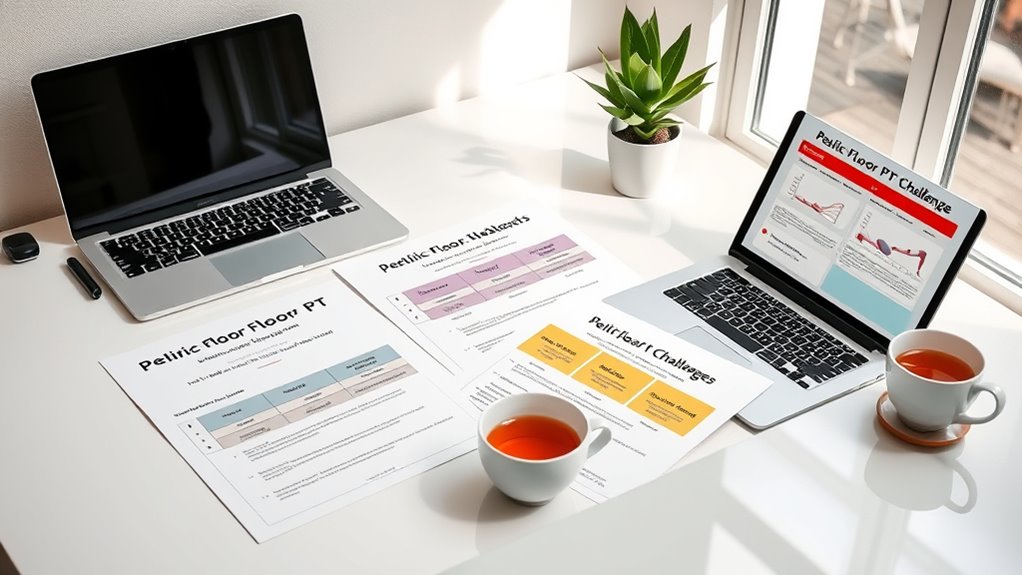
Incorporating healthy lifestyle habits can substantially boost your pelvic-floor exercise results. Small changes in daily routines make a big difference. Prioritize maintaining a healthy weight, as excess weight puts pressure on your pelvic muscles. Stay hydrated to support tissue health and prevent constipation, which can strain your pelvic area. Incorporate regular physical activity, like walking or gentle yoga, to improve overall strength and circulation. Finally, avoid heavy lifting and straining during bowel movements to reduce undue pressure. Supporting pelvic health through lifestyle is an essential component of a comprehensive approach to postpartum recovery and long-term pelvic well-being. These habits complement your exercises, helping you achieve better outcomes and long-term pelvic health.
Common Challenges and How to Overcome Them

Many people face common challenges when starting pelvic-floor exercises, such as difficulty staying consistent or feeling unsure if they’re doing the exercises correctly. To overcome this, set a regular schedule and add reminders, making it part of your daily routine. If you’re unsure about proper technique, consider consulting a physical therapist for guidance or using visual aids and printable instructions to guarantee correct form. Don’t get discouraged by slow progress; patience is key. Break exercises into smaller, manageable steps to build confidence. Tracking your progress can boost motivation and help identify areas needing improvement. Remember, setbacks are normal—stay committed and adjust your approach as needed. Incorporating educational resources like instructional guides can reinforce proper technique and understanding. With persistence and proper guidance, overcoming these challenges will lead to better results.
Celebrating Milestones and Achievements
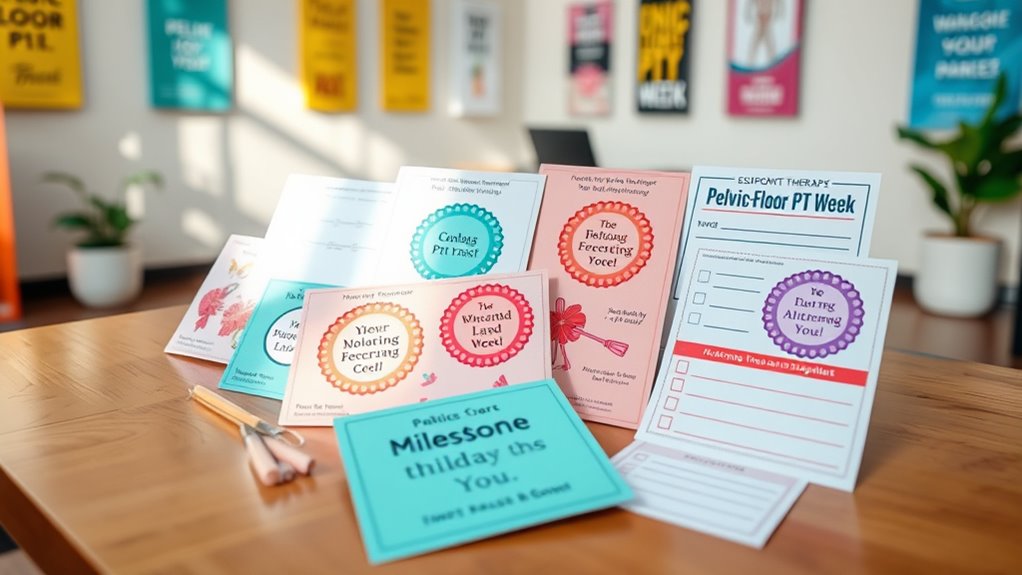
Celebrating your milestones keeps you motivated and focused on your progress. Tracking your achievements helps you recognize growth and stay committed to your goals. Incorporating rewards can make celebrating even more rewarding and inspiring for your journey. Recognizing your dog’s name preferences can also deepen your bond and make your milestones more meaningful.
Tracking Progress Effectively
Tracking your progress is essential for staying motivated and recognizing how far you’ve come. It helps you see improvements, identify patterns, and stay committed. To do this effectively, consider using various methods to monitor your progress.
- Keep a journal or daily log of exercises and sensations
- Use a progress tracker or printable charts
- Record your feelings and challenges regularly
- Take photos or measurements to visualize changes
Celebrating Personal Goals
Recognizing your personal goals is a powerful way to stay motivated and build confidence in your pelvic-floor journey. Celebrating milestones reminds you of how far you’ve come and fuels your commitment. Whether you’ve improved control, reduced discomfort, or achieved a specific target, honoring these wins keeps your spirits high. Create a simple celebration system to mark each milestone. Here’s an example:
| Goal Achieved | How You Celebrated | Next Step |
|---|---|---|
| Improved bladder control | Treated yourself to a massage | Set new strength goals |
| Completed 4 weeks of exercises | Shared progress with a friend | Increase exercise intensity |
| Reduced discomfort | Took a relaxing walk | Focus on maintaining progress |
Motivational Rewards System
Establishing a motivational rewards system can substantially boost your progress by giving you tangible reasons to stay committed. Celebrating milestones keeps your spirits high and reinforces your dedication. To make it effective, choose rewards that motivate you personally and feel meaningful. For example, you might:
- Treat yourself to a relaxing massage after completing a set number of sessions
- Buy a small gift when you reach a milestone
- Enjoy a favorite activity or meal as a celebration
- Track your achievements visually, like marking a calendar or progress chart
These rewards serve as positive reinforcement, helping you stay focused and motivated throughout your pelvic-floor journey. Remember, celebrating small wins fuels continued effort and keeps your goals within reach.
Resources for Continued Support and Learning
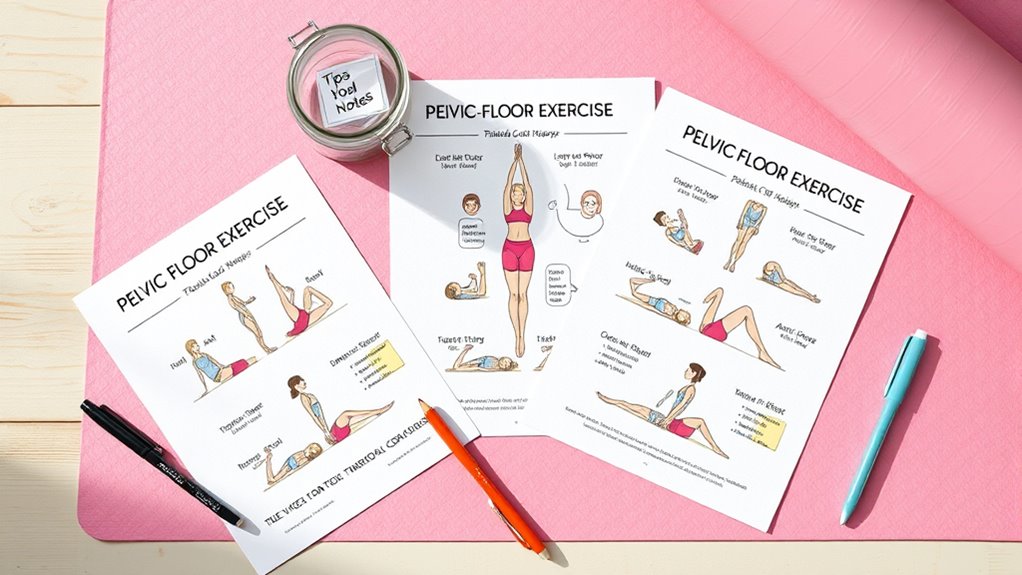
To continue your progress beyond pelvic-floor PT week, exploring reliable resources can provide valuable support and ongoing education. Books, reputable websites, and online courses offer detailed information to deepen your understanding of pelvic health. Consider consulting organizations like the International Continence Society or the American Physical Therapy Association for trusted guidance. Support groups, whether online or in-person, can connect you with others on a similar journey, giving you encouragement and shared experiences. Podcasts and webinars featuring pelvic health experts can keep you informed about new research and techniques. Additionally, follow trusted professionals on social media for tips and motivation. These resources help reinforce your knowledge, answer questions, and keep you engaged, empowering you to maintain your pelvic health with confidence.
How to Maintain Your Pelvic Health Long-Term
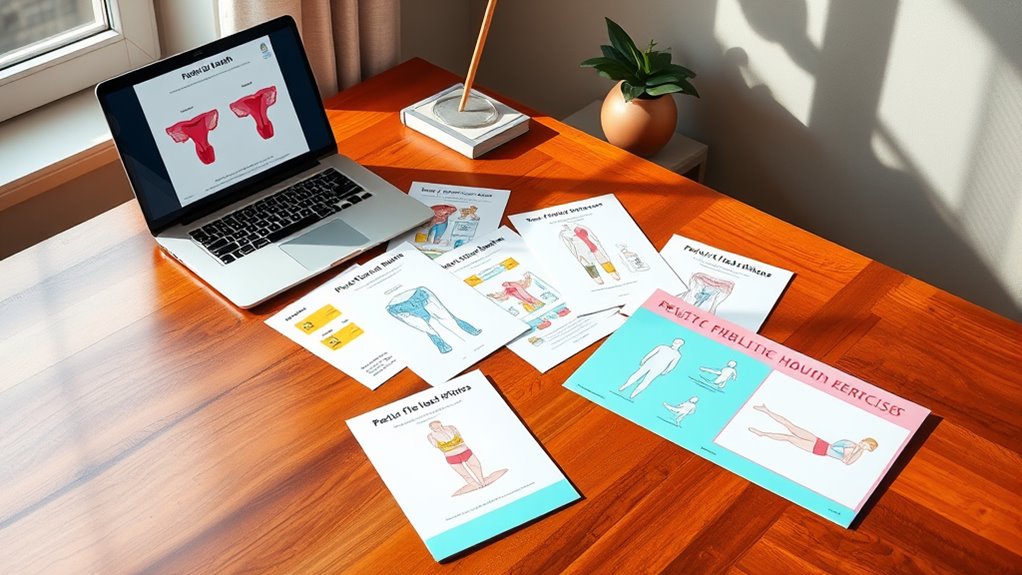
To keep your pelvic health strong, sticking to a consistent exercise routine is key. Making healthy lifestyle choices and staying active also support long-term wellness. Don’t forget to schedule regular checkups with your healthcare professional to catch any issues early.
Consistent Exercise Routine
Maintaining a consistent pelvic-floor exercise routine is essential for long-term pelvic health, but it requires commitment and planning. To stay on track, set realistic goals and schedule workouts at the same time each day. Track your progress to stay motivated and identify areas for improvement. Vary your exercises to target different muscles and prevent boredom. Keep your routines manageable so they become a habit rather than a chore.
- Schedule regular workout times
- Track your progress and adjust as needed
- Incorporate a variety of exercises
- Set achievable, clear goals
Healthy Lifestyle Choices
Building healthy habits beyond your exercise routine can substantially boost your pelvic health over the long term. Prioritize balanced nutrition to support tissue strength and overall well-being. Stay well-hydrated to prevent urinary issues and promote healthy bladder function. Maintain a healthy weight, as excess weight puts pressure on your pelvic floor. Practice good posture throughout the day to reduce strain. Avoid smoking, which can impair tissue repair and lead to chronic issues. Manage stress through relaxation techniques, since stress can tighten pelvic muscles or cause tension. Limit caffeine and alcohol, as they can irritate your bladder. Consistently applying these lifestyle choices helps protect your pelvic health, enhances your exercise efforts, and encourages long-lasting results.
Regular Professional Checkups
Scheduling regular professional checkups is essential for catching potential pelvic health issues early and ensuring your maintenance plan stays on track. These visits allow your healthcare provider to assess your pelvic muscles, address concerns, and adjust exercises if needed. Consistent checkups help prevent problems from worsening and keep your pelvic health ideal. To make the most of these visits, consider:
- Keeping a symptom diary to share updates
- Asking questions about new or ongoing issues
- Following your provider’s recommended exercises
- Staying consistent with your pelvic health routine
Frequently Asked Questions
Can Pelvic-Floor Exercises Be Safely Done During Pregnancy?
You might wonder if pelvic-floor exercises are safe during pregnancy, and generally, they are. These exercises can strengthen your pelvic muscles, support your growing bump, and ease labor. However, it’s essential to consult your healthcare provider before starting or continuing any routine. They can guide you on the right exercises and modifications suited for your pregnancy, ensuring you stay safe and comfortable throughout this special time.
How Do I Know if I Am Engaging the Correct Muscles?
Imagine your pelvic muscles as a gentle garden fence, keeping everything secure. To know if you’re engaging the right muscles, try stopping your urine flow midstream—if you can do it without using your thighs or buttocks, you’re on the right track. You might also place a finger inside your vagina or anus to feel the squeeze. Keep practicing until you confidently distinguish these muscles from others.
Are There Specific Printable Activities for Postpartum Recovery?
You can find printable activities designed specifically for postpartum recovery that guide you through gentle exercises and pelvic floor strengthening. These printables often include step-by-step instructions, diagrams, and reminders to stay consistent. They’re great for tracking progress and ensuring you’re doing the movements correctly. Look for reputable sources, such as physical therapy clinics or trusted health websites, to get safe, effective activities tailored to your postpartum needs.
How Long Should I Expect to See Improvements?
They say patience is a virtue, and that’s especially true for pelvic-floor recovery. You might start noticing improvements in a few weeks, but it can take several months to see full progress, depending on your situation. Consistency is key—stick with your exercises and follow your therapist’s guidance. Remember, slow and steady wins the race, so be kind to yourself during this healing journey.
Can Pelvic-Floor PT Help With Bowel or Bladder Issues?
Pelvic-floor PT can definitely help with bowel and bladder issues. It targets the muscles responsible for control, improving strength and coordination. By working with a specialized therapist, you learn exercises to reduce leaks, urgency, or constipation. Most people notice improvements within a few weeks, but consistency is key. With dedicated effort, you can regain better control and reduce discomfort, leading to a more comfortable, confident daily life.
Conclusion
Remember, your pelvic-floor journey is a marathon, not a sprint. Every small step you take strengthens a foundation that supports your overall well-being. Celebrate each milestone, no matter how tiny, because each one brings you closer to a healthier, more confident you. Stay committed, be patient with yourself, and know that with persistence, your efforts will blossom into lasting strength. You’ve got this—your wellness story is waiting to be written.
